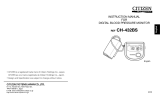- Eng 4 - - Eng 5 -
PRECAUTION FOR USE AND MAINTENANCE
PRECAUTION FOR USE AND MAINTENANCE
English
Precaution for use
1. If you suffer from heart disease, high blood pressure or other
circulatory disease, please consult your physician first.
2. If you feel abnormal pressure of the cuff during use or other
irregularity, reduce the pressure immediately by depressing “Exhaust
button” and consult the sales outlet where purchased.
3. If you think the measured value is abnormal or if measuring makes
you feel unwell, discontinue use and consult your physician.
4. Measurement of blood pressure may not be possible for someone
with a weak pulse or arrhythmia.
5. If blood pressure is measured repeatedly, congestion, swelling, etc.
may occur in some people.
6. If blood pressure is measured repeatedly, an accurate result will not
be achieved. An interval of about 3 minutes should be allowed.
7. Consult your physician before use if you suffer a severe disorder of
blood circulation in the arms. Failure to do so may cause health
hazards.
8. Measurement may not be possible for someone with an insufficient
blood flow in the area to be measured or frequent irregular
heartbeats. Consult your physician for judgment.
9. DO NOT wrap the cuff around an injured arm.
10.DO NOT wrap the cuff to the arm where a drip (intravenous infusion)
or blood transfusion under medical treatment. Failure to do so may
cause an injury or a serious accident.
11.DO NOT use in the vicinity of flammable gases such as anesthetic
gases because of the risk of ignition and explosion.
12.DO NOT use in enriched oxygen environments such as a hospital’s
hyperbaric chamber or oxygen tent because of the risk of ignition and
fire.
13.DO NOT use a mobile phone near the unit. Doing so may result in
malfunction.
14.If you use a cardiac pacemaker, consult your physician before use.
15.Be sure to use this unit only for measuring blood pressure. DO NOT
use it for any other purpose.
16.DO NOT use this unit on an infant.
17.This product uses natural rubber for the rubber bulb.
The natural rubber may cause any allergic reaction such as itching,
flare, urticaria, swelling, fever, difficult breathing, asthma status,
blood pressure drop or any shock.
* If any of the symptoms as shown above is observed, immediately
stop using this product and consult your physician.
18.Blood pressure measurements determined with this device are
equivalent to those obtained by a trained observer using the
cuff/stethoscope auscultation method, within the limits prescribed by
the American National Standard, Electronic or automated
sphygmomanometers.
19.Measurement of blood pressure may not be possible for someone
with a common arrhythmias such as atrial or ventricular premature
beats or atrial fibrillation.
Precaution for maintenance
1. DO NOT store the blood pressure monitor where it will be exposed to
direct sunlight, high temperature (over 60°C), low temperature (below
-20°C), high relative humidity (over 95%) or in a dusty place.
2. DO NOT drop or expose the blood pressure monitor to under force or
vibration.
3. Remove the battery/batteries when not in use for a long period.
4. DO NOT disassemble the apparatus.
5. DO NOT bend the cuff or air hose unnecessarily.
6. When the monitor is very dirty, wipe it clean with a cloth moistened
with Sterilizing alcohol or a neutral detergent, and then wipe it with a
dry cloth.
7. NEVER wipe the blood pressure monitor with thinner or benzene, as
they may damage it.
8. Please wipe the cuff with moist cloth. Hard rubbing will cause Air
leaking. Also, be careful not to get water into the air hose.













